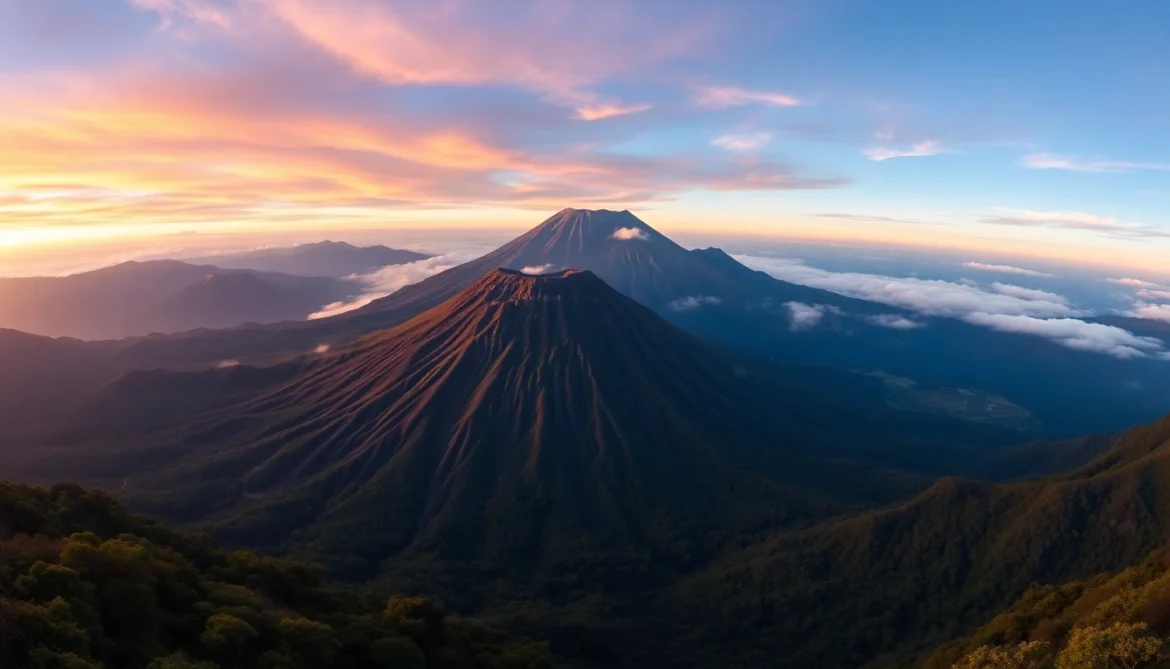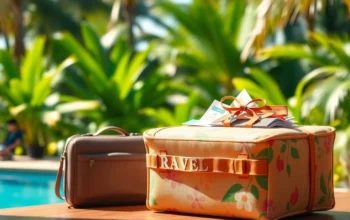Introduction to Mount Rinjani
Located on the vibrant island of Lombok in Indonesia, Mount Rinjani stands as one of Southeast Asia’s most awe-inspiring natural marvels. As the second highest volcano in Indonesia, soaring to an impressive 3,726 meters (12,224 feet) above sea level, Rinjani boasts a rugged beauty that draws adventurers, nature lovers, and cultural enthusiasts alike. Its prominence in Indonesia’s geography, history, and local culture makes it not just a mountain, but a symbol of resilience and spiritual significance for the surrounding communities.
This active stratovolcano is situated within the Gunung Rinjani National Park, a protected area characterized by diverse ecosystems, breathtaking landscapes, and abundant biodiversity. Visitors and trekkers flock here year-round, eager to witness the panoramic views, volcanic craters, and scenic waterfalls that define Rinjani’s unique terrain. Beyond its physical features, Rinjani’s cultural narratives and legends add profound depth to its allure, making it a must-visit destination for those seeking both adventure and spiritual enrichment.
Geographical and Geological Overview
Location and Physical Characteristics
Gunung Rinjani is situated in North Lombok Regency, within the boundaries of the Rinjani National Park, covering over 41,000 hectares of lush forests, volcanic formations, and pristine lakes. The mountain’s massive caldera harbors Segara Anak, a stunning crater lake renowned for its vibrant blue waters and spiritual significance. The volcano itself is a complex stratovolcano comprising multiple cones and overlapping craters formed through millennia of eruptions.
Volcanic Activity and Formation
As an active volcano, Rinjani’s geological history is marked by significant eruptions, most notably the catastrophic 1257 eruption of the Samalas volcano, which profoundly impacted global climate. The current structure has been shaped by ongoing geological processes, with eruptions occurring approximately every few decades, most recently in 2016. Its activity remains monitored by local authorities to ensure safety and preparedness, but its eruptions have historically contributed to its rugged scenery and fertile soils that sustain Lombok’s ecosystems.
Unique Ecosystems and Biodiversity
Mount Rinjani serves as a biogeographical transition zone, supporting diverse flora and fauna across its altitudinal gradients. The park’s ecosystems range from tropical rainforests at its base to alpine vegetation near the summit. Wildlife includes endemic species such as the Lombok spider, black monkeys, and various bird species, making the region a haven for ecotourism and conservation efforts.
Cultural Significance and Local Legends
For the local Sasak and Balinese communities, Rinjani is more than a geographic feature—it is a spiritual beacon rooted in their mythology and ancestral traditions. The mountain is considered sacred, believed to be the dwelling of spirits and gods that influence daily life and harvests.
Mythology and Spiritual Beliefs
Legend speaks of Mount Rinjani as the spiritual origin of Lombok’s people, with stories dating back centuries describing how deities inhabit its summit and craters. The Segara Anak lake is regarded as sacred, serving as a site for purification rituals and offerings. Many pilgrims undertake spiritual journeys here, especially during traditional ceremonies, seeking blessings and divine favor.
Architectural and Cultural Sites
Near the mountain are several temples and sacred sites where local ceremonies are performed, especially during the annual Rinjani Festival. Cultural performances, traditional dances, and storytelling sessions actively preserve and transmit the mountain’s mythos across generations, reinforcing its place in Lombok’s cultural identity.
Why Mount Rinjani Is a Must-Visit Destination
Beyond its physical grandeur, Mount Rinjani offers an unparalleled combination of adventure, nature, and cultural richness. The trek to its summit is considered one of Southeast Asia’s most rewarding hiking experiences, challenging even seasoned climbers with its varied terrains, altitude, and unpredictable weather. The view from the top, overlooking the island and the surrounding Indonesian archipelago, is a once-in-a-lifetime spectacle.
Its appeal extends to diverse traveler interests: geology buffs can marvel at volcanic formations, birdwatchers can spot rare species, and cultural enthusiasts can immerse in local traditions. The surrounding national park provides a sanctuary for nature conservation while also offering eco-friendly tourism opportunities. For those seeking an authentic adventure that combines physical challenge with spiritual discovery, Mount Rinjani remains an unbeatable destination.
Preparing for Your Mount Rinjani Trek
Best Seasons and Optimal Booking Tips
The prime trekking season runs from May to October, coinciding with the dry season in Lombok. During these months, weather conditions tend to be cooler, with less rainfall and clearer skies, optimizing visibility and safety. Planning well in advance is essential; permits, guided tours, and accommodation bookings fill quickly during this period. Booking through reputable tour operators ensures safety, appropriate equipment, and local expertise, enhancing the overall experience.
Essential Equipment and Supplies
Successful Rinjani treks demand meticulous preparation. Essential gear includes layered clothing suitable for cold and wind, sturdy hiking boots, rain protection, headlamps, and trekking poles. Nutrition and hydration are critical; bring energy-dense snacks, water purification tablets, and sufficient drinking water. Camping gear is necessary if opting for overnight treks. As the altitude increases, packing warm clothing and anti-altitude sickness medications is advised.
Physical Preparation and Training Tips
Given the mountain’s challenging terrain, physical fitness is vital. Activities such as endurance hikes, stair climbing, and strength training prepare the body for sustained exertion. Prioritize cardiovascular health, leg strength, and core stability. Simulate trekking conditions with weighted backpacks and varied terrains before the trip. Additionally, mental preparedness and acclimatization exercises help build resilience against altitude sickness and fatigue.
Planning Your Rinjani Adventure
Popular Routes and Trekking Difficulty Levels
There are multiple routes to reach Rinjani’s summit, each with varying difficulty levels. The Sembalun route is renowned for its scenic vistas and moderate challenge, making it suitable for most trekkers. The Senaru route offers lush tropical landscapes but requires a higher level of fitness due to steeper sections. For experienced climbers, the Torean route presents more technical climbing challenges.
Guided Tours vs. Independent Trekking
While independent trekking is possible, guided tours are highly recommended to ensure safety, logistical support, and local insights. Reputable guides provide valuable information about trail conditions, safety protocols, and cultural sites. They also help secure permits and manage environmental impact. Conversely, independent trekking requires thorough planning, knowledge of the terrain, and self-sufficiency, making guided options preferable for most travelers.
Permits and Park Regulations
Entering Rinjani National Park necessitates pre-arranged permits, generally included in guided tour packages. Regulations aim to preserve the ecological integrity and cultural heritage of the area. Visitors must adhere to designated trails, avoid littering, and refrain from disturbing wildlife. Respectful behavior towards local communities and sacred sites is essential. Responsible tourism ensures the preservation of Rinjani’s natural beauty for future generations.
Experiencing Mount Rinjani
Highlights and Scenic Spots Along the Trail
The trek unveils numerous iconic sights, including lush rainforests, volcanic craters, hot springs, and waterfalls. The ascent to the summit offers stunning vistas of the surrounding islands and the coastline. Noteworthy stops include the serene Segara Anak Lake, the picturesque Sendang Gile Waterfall, and the Sultan’s Crater. Exploring these sites enriches the journey, providing both visual delights and cultural insights.
Wildlife and Nature to Observe
Rinjani’s ecosystem teems with endemic and migratory species. Birdwatchers can spot hornbills, kingfishers, and eagles, while the park’s forests shelter primates, lizards, and unique insect species. The varied flora—ranging from medicinal plants to rare orchids—supports a resilient natural habitat. Maintaining environmental awareness while observing wildlife ensures minimal disruption to this delicate ecosystem.
Safety Tips for a Successful Climb
Preparation, awareness, and caution are crucial. Trekkers should monitor weather updates, avoid hiking during storms, and respect altitude sickness symptoms. Adequate hydration, pacing, and acclimatization reduce health risks. Having experienced guides, appropriate gear, and a contingency plan for emergencies enhances safety. Finally, maintaining a respectful attitude towards the environment and local traditions fosters a positive and sustainable experience.
After the Trek: Enjoying Lombok and Beyond
Local Culture and Food Experiences
Post-trek, visitors can indulge in Lombok’s rich culinary traditions—try traditional Sasak dishes like ayam taliwang (spicy grilled chicken) and plecing kangkung (vegetable salad). Engage with local artisans in markets selling textiles, carvings, and souvenirs. Participating in cultural ceremonies or traditional performances deepens understanding and appreciation of Lombok’s heritage.
Other Attractions Near Mount Rinjani
Beyond Rinjani’s base, Lombok offers pristine beaches, such as Kuta Beach and Selong Belanak, perfect for relaxation and water sports. Gili Islands—Gili Trawangan, Gili Air, and Gili Meno—are renowned for their coral reefs and vibrant nightlife. Waterfalls like Tiu Kelep and Sendang Gile, as well as nearby waterfalls and hot springs, provide additional exploration options for nature enthusiasts.
Environmental Responsibility and Conservation Efforts
Protecting Rinjani’s fragile ecosystem requires collective responsibility. Visitors should abide by park regulations, minimize waste, and use eco-friendly products. Supporting local conservation projects and eco-tourism initiatives contribute to sustainable development. Educating oneself about the environmental challenges faced by Rinjani, such as deforestation and pollution, encourages responsible tourism and forest preservation efforts.

